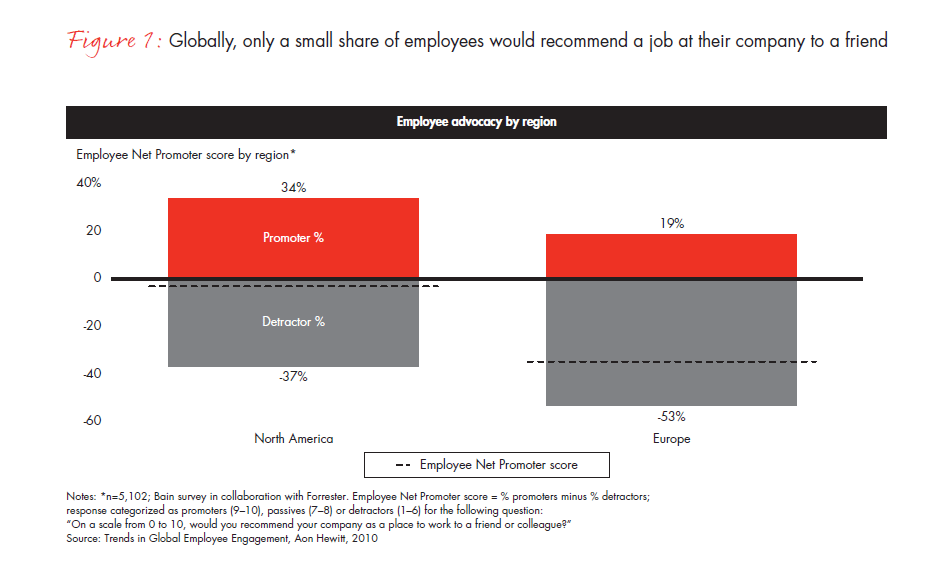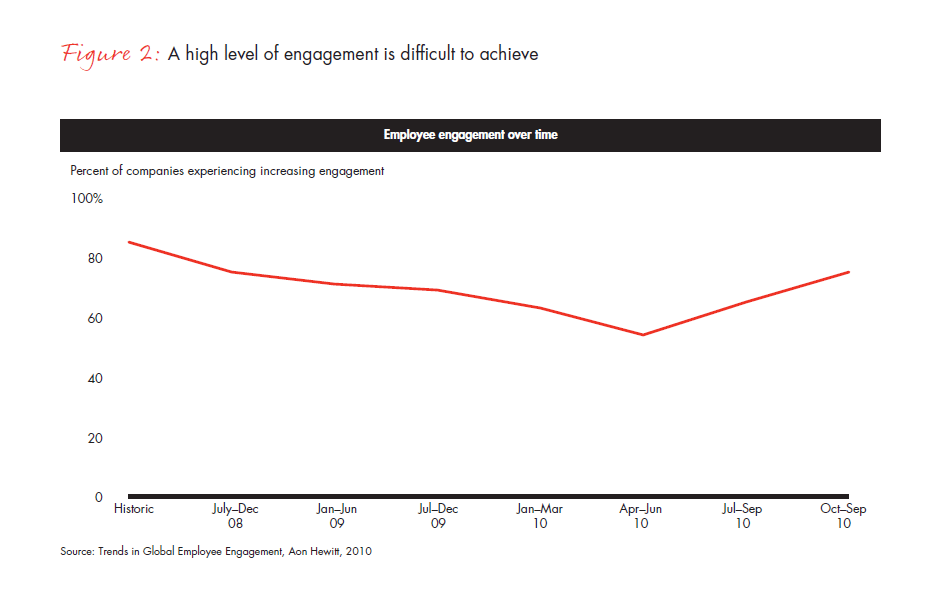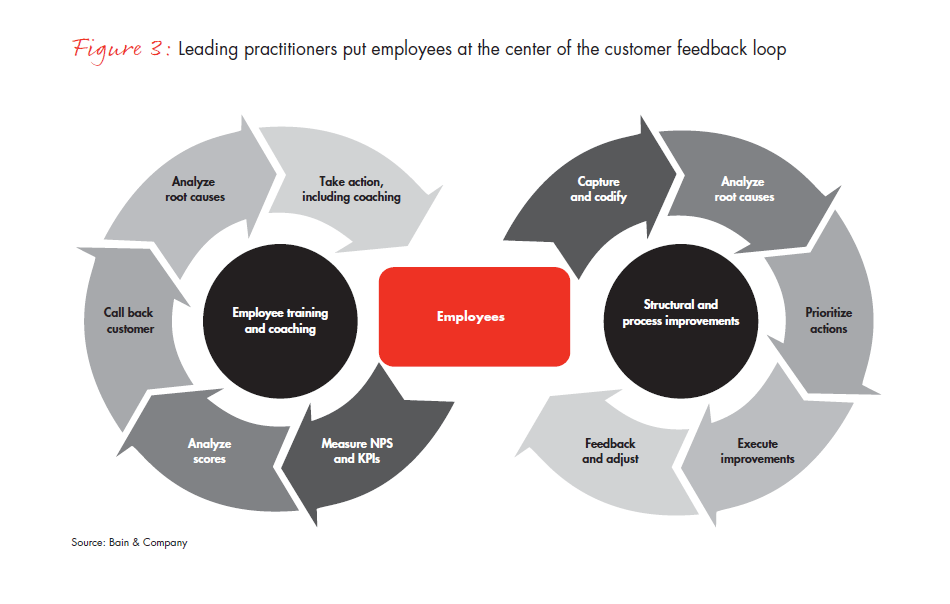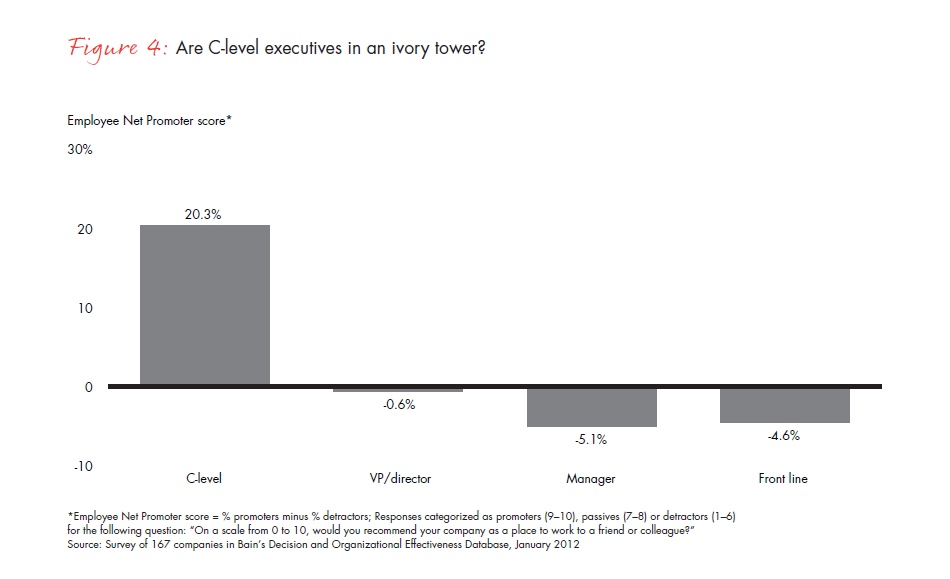CEO Forum
How is it that year after year, JetBlue Airways ranks first in J.D. Power and Associates North America Airline Satisfaction Study for the low-cost carrier category, with high levels of customer loyalty and advocacy? The key ingredient: JetBlue employees treat customers’ problems as their own.
Running late for a flight? You might be escorted by a JetBlue counter agent to an “employees only” security line, right through to the gate. Putting together a complicated multistop trip? The call center agent will work with you to arrive at a satisfactory solution, not rush you off the phone. JetBlue staff members focus intensely on making the customer’s life easier, and customers repay the courtesy by spreading the word to others.
Organizations have been trying for years to cultivate employee engagement. Like JetBlue, they persist in their efforts for good reason. One of the most powerful factors that spur customers to become advocates for a company is employees’ positive behavior and attitude. Bain consumer surveys show that the overall experience of dealing with a company often matters much more to customers than price or brand or—in industries with a big service component, such as home insurance and retail banking— even product features alone.
Engaged employees go the extra mile to deliver. Their enthusiasm rubs off on other employees and on customers. They provide better experiences for customers, approach the job with energy—which enhances productivity— and come up with creative product, process and service improvements. They remain with their employer for longer tenures, which reduces turnover and its related costs. In turn, they create passionate customers who buy more, stay longer and tell their friends— generating sustainable growth.
As a result, over seven years, companies with highly engaged workers grew revenues two and a half times as much as those with low engagement levels.1 And stocks of companies with a high-trust work environment outperformed market indexes by a factor of three from 1997 through 2011.2
One reason for this superior performance is that engaged employees direct their energy toward the right tasks and outcomes. Compensation and benefits still matter to employees, of course. But when it comes to engagement, other characteristics of the workplace matter even more: a strong sense of purpose, ample autonomy, opportunity for growth and a sense of affiliation. As one employee of online retailer Zappos put it, “The golden rule is the way of life here.”
Organizations with highly engaged employees often seem to be powered by an inner force, a mantra that crystallizes the company’s processes and employee behaviors into a compelling summation of “what we’re all about.” The mantra shapes how employees carry out their tasks and gives them confidence to use their judgment. And when the true source of job satisfaction, happiness and recognition derives from enriching customers’ experiences, good things happen.
While the benefits of high engagement are clear, the available data show it is difficult to achieve. Among a broad group of global companies surveyed in late 2010, only a small share of employees said they would recommend a job at their company to a friend or relative. Moreover, engagement declined steadily since the financial crisis in 2008, though it rebounded at the end of 2010, the latest data available (see Figures 1 and 2).

In our view, too many companies try to raise engagement by launching disconnected initiatives like wellness programs. Such initiatives might improve employee morale slightly and serve other purposes, but they’re detached from customers’ priorities. They lack the specific mechanisms that lift employee engagement the most over a long period and link directly to customer advocacy.
A better system to earn engagement
Companies that have substantially raised employee engagement act differently. They go beyond the basic prerequisites of employee satisfaction, which include an emotionally safe environment, the right tools to get work done and fair compensation. These trailblazers manage to instill an extraordinary sense of purpose and autonomy, as well as strong affiliation with the company and its offerings. They take a systematic approach, focusing on a few key areas.

Measure employee engagement just like customer engagement and tightly link the two
It’s intuitive that customer advocacy closely correlates with employee engagement. But when it comes to understanding employees’ attitudes and behavior, many companies are data rich but information poor. They use focus groups and long surveys to capture data, but find it difficult to generate insights that can inform smart business decisions to raise customer loyalty.
One effective way to track and measure the link between customer advocacy and employee engagement is to use a metric we call the Net Promoter® score (NPS®). The company asks customers a single question: How likely are you to recommend [this company or product] to a friend or colleague? Respondents giving marks of nine or 10 are promoters—the company’s most devoted customers. Those scoring their experience at seven or eight are passives, and those scoring it from zero to six are detractors. NPS is the percentage of promoters minus the percentage of detractors.
Promoters are enthusiastically loyal to the brand, the company and the product. They sing the company’s praises to others and they buy more and stay longer. Detractors, on the other hand, actively tell others about their terrible experiences.
The rewards of customer advocacy can be substantial. In the telecommunications industry, for example, a few percentage points gain in customer NPS would translate into hundreds of millions of dollars in customer base value for a large provider. This occurs through an accretion of benefits: Promoters leave a company, on average, much less frequently than detractors or passive customers do, leading to higher lifetime revenues; promoters also encourage other people to join as customers at a much higher rate than passives or detractors do.
The Net Promoter metric turns out to have profound implications for a company’s culture and how employees go about their work. Staff in product development, for instance, might need to change the way they calibrate success—not just high initial sales, but high sales plus a high NPS.
Just as the Net Promoter approach has strong descriptive and predictive power with customers, it works just as well in the realm of employee engagement. Loyalty leaders measure engagement by asking a handful of simple but predictive questions: Would you ask your friends and family to work in this company? Why? And would you recommend our product or service to your friends and family? What would you tell them? They then sort employees into promoters, passives and detractors.
Conventional satisfaction surveys often serve as a security blanket to reassure executives—we have a high score, so everything must be fine. In contrast, the point of Net Promoter questions is to really listen to what customers and employees say about their needs and priorities.
The Net Promoter approach has a radical simplicity that appeals to frontline, back-office and managerial employees alike. And our experience has demonstrated a strong relationship between the employee and the customer metrics. The reasons that customers become advocates or detractors are highly related to the degree of employee engagement. Companies that track NPS in both groups thus have an advantage over competitors in monitoring an important source of customer advocacy.
Put employees squarely at the center of customer feedback loops
To make progress with the Net Promoter system, it’s critical to build customer feedback into daily operations and then “close the loop” with employees (see Figure 3). This entails soliciting feedback from customers (Would you recommend and why?) after an important interaction or as part of a relationship assessment, then quickly sharing the comments with the employees most responsible for the experience. After the initial question, it’s often useful to have the employees who handled the interaction call back a sample of customers to ask more detailed questions, in order to probe for problems that may be causing detraction.
Such questions helped Belgacom, a telecommunications provider in Belgium, reduce the excessive flow of customer inquiries to its call center. Workshops with employees generated many hypotheses about what prompted the calls, and the company used customer feedback loops to winnow the hypotheses to a handful that merited attention. Among the causes of detraction were confusing bills and product installation guides, limited call center hours and long phone wait times. Armed with this solid data, Belgacom set about revising each of these areas, which helped to sharply reduce the volume of calls and increase customer NPS scores.
Feedback loops clearly illuminate the peaks and valleys of the customer’s experience with a sales or service representative or an account team. They make the consequences of an employee’s actions visible. Fast timing is essential because an employee serving a customer needs to remember the interaction that generated the feedback, which rarely happens when data is aggregated months later. The feedback should also be shared with direct supervisors, product designers, engineers, pricing executives and others who create the policies, processes or product features that indirectly shape the experience.
One has to be selective with feedback loops so that they don’t become overwhelming or too expensive. The focus should be on a few “moments of truth” that shape the customer’s attitude toward the company. At a wireless telecom carrier, moments of truth include how the carrier handles the activation process, errors on the first invoice or loss of a phone. At an airline, such moments include how the company handles a delayed flight, lost baggage or frequent-flyer mile redemption.
Leading Net Promoter practitioners, such as investment firm Charles Schwab, also work hard to contact detractors, usually within 24 hours after the initial survey. This prompt response signals to the customer that the company really does value his or her opinion, and it provides a unique opportunity for coaching. Comments from customers, delivered quickly and in detail to financial consultants and other frontline employees, provide the basis for constructive criticism. Employees collectively can learn, adjust their behaviors and take appropriate actions with the customer.
Feedback should not dwell exclusively on problems. Hearing a customer’s descriptions of how an employee’s actions had a positive effect can be a powerful reinforcement of desired behaviors and reminder of the employee’s purpose. The feedback process is as much about reinforcing what employees should do and are doing right as it is about correcting what they did wrong.
With a little imagination and experimentation, companies can apply the feedback loop concept to parts of the organization that don’t directly touch customers but indirectly have an effect on the customer experience. For example, Belgacom has begun to use a Net Promoter lens in its marketing function. Marketing staff used to write and publish training guides and scripts for the call center just before a new product launch. If the scripts were confusing to call center representatives, revisions came too late to make much of a difference. Now the marketing staff tests the prototypes with call center representatives well in advance, using a feedback loop to improve the scripts, which ultimately makes for better interactions with customers.

Change performance metrics to emphasize customer advocacy
Performance metrics can be powerful incentives for behavior. Rate employees along metrics of time or cost, and they will respond in kind, even if that degrades the customer experience. Many call centers, for instance, have structured their performance reviews around cost-driven metrics such as “average handle time” for calls. When representatives then try to keep calls as short as possible, they’re unable to solve complicated customer problems, driving up the number of repeat customer calls and the level of customer frustration.
Companies that pursue the Net Promoter approach usually adjust their metrics to promote customer advocacy rather than low costs at any price. At Belgacom, the call center switched from using average handle time to a combination of two metrics, one on customer promotion and the other on resolving the issue on the first call. Previously, a difficult case would get transferred to phone-tree purgatory; now a representative has the power to raise her hand for a nearby technical expert to join the call. Not only does the new approach help to reduce the overall volume of calls by 20%, it also ignites higher customer scores and employee engagement scores.
Give employees freedom within a framework to improve the customer experience
Masters of engagement change their processes to give employees greater decision-making autonomy because people on the front lines have a great influence over the quality of the customer experience. These companies listen to employee feedback through such techniques as weekly online polls, brainstorming wikis and agenda-free town hall meetings. That can pay huge dividends for both customers and employees.
Consider the typical customer call center. Employees read from a script like machines and have rigid protocols for every interaction, which tends to leave them feeling constrained and irritated. In contrast, an investment management company that we will call Alpha listened to feedback from its high-net-worth customers and its call center representatives. Based on that feedback, Alpha gave its call center representatives much greater autonomy in dealing with those “flagship” customers. For instance, if the customer fills out an application incorrectly, the representative can send it back via overnight delivery, despite the higher cost, and can include a handwritten note.
Along with listening closely, engagement masters encourage, or even mandate, cross-functional collaboration. JetBlue promotes a system of “desired behaviors” that fosters a collaborative work environment to improve customer service. For example, the airline encourages pilots, flight attendants and gate agents to work together to help clean the main cabin, which reconciles potential conflict between cabin cleanliness and speed of turnaround between flights, since the aircraft crew is responsible for both.
The most effective companies nest these practices in an explicit decision framework, where employees have clear rights and accountabilities for the daily operational decisions that can add or destroy value. That does not mean “anything goes”; employees should rely on the systems and processes put in place to improve customer advocacy. But higher decision effectiveness has a strong correlation with greater employee engagement, Bain research shows.
Recognize and make the most of linchpin roles
Not all roles are created equal. Many companies don’t take the trouble to understand which are their linchpin roles—as distinct from high-performing or high-potential people. These are roles that have a big influence on the customer experience or that provide critical support or coaching to employees who shape the customer’s response. Given scarce resources, targeting these roles can be an efficient way to raise employee engagement and thus customer advocacy.
Linchpin roles often include frontline supervisors and managers, who exert a great deal of influence behind the scenes. We have found that local manager engagement is highly correlated with local team engagement, which in turn correlates with better customer NPS scores. Skilled managers, it appears, help to raise the enthusiasm and sharpen the focus of team members whose behavior serves to delight customers.
When Cintas, a business-to-business products and services provider, analyzed its talent practices, the company confirmed the link between effective managers and engaged frontline employees (whom they call partners), as well as the connection between engaged employees and engaged customers. So Cintas revisited the role of its frontline managers and increased its investment in recruiting, hiring and training. It also invested in tools that enable managers to become better coaches to their team members.
At other companies, the linchpin roles may include Six Sigma black belts or similar quality experts skilled at turning raw customer feedback into meaningful improvements in business processes. At one midsize airline, a cross-functional quality team aggregates customer feedback data and searches for patterns that signal which areas are causing lower NPS scores. They choose which issues merit a quick response—say, poor baggage handling—and then work with the relevant departments to make improvements to the process in question.
Overcoming the organizational barriers
High employee engagement lies within a company’s grasp—if one pays attention to the connection between customer and employee advocacy. The challenge is to delight both groups at the respective moments of truth— the pivotal moments that hold the greatest potential to build engagement or, conversely, to alienate a person. For employees, these consist of professional moments such as a reorganization, a new boss or a plan to improve a crucial business process; customer moment such as calls to resolve a problem; and personal moments such as a medical leave or relocation.
Building the ranks of promoters among customers and employees will involve breaking through boundaries drawn between internal functions, such as operations, HR and sales. It might require close cooperation among several functions—not just customer service agents and their supervisors, but also the sales team (to avoid overpromising or to better qualify potential customers), and human resources (to change recruiting and training methods).
Senior executives must stay connected to the activities of frontline employees, the ones who see the customer experience up close with all its blemishes. Otherwise, employees’ concerns and ideas will go unheard, and engagement will suffer in the lower ranks of the organization (see Figure 4). Active management to promote both customer advocacy and employee engagement requires a balance of consistency in some areas and variation in others. Consistency should apply up and down the ranks in how the company encourages behavior that will improve the customer experience. Every department or unit should be singing from the same song book. But the tools and performance metrics can vary from one unit to another, as long as they all work toward a similar outcome.

A leading telecommunications provider, which we will call BigTel, illustrates how this balance plays out in practice. BigTel’s call center representatives cherish receiving positive feedback from customers every day. Technicians in the field, in contrast, usually work solo and take pride in being able to fix anything. The company made sure to give each group the proper tools and processes to do their jobs well. For call center representatives, that meant more intensive coaching by supervisors. For field technicians, it took the form of upgraded diagnostic tools and dedicated training on how to deal with ad hoc customer requests, such as “While you’re here, could you just fix this one more thing for free?”
BigTel added a Net Promoter metric to the technicians’ performance assessment, namely, whether the customer later called back for any reason, which was a proxy for “first time right.” Among both groups, new metrics supported by the appropriate tools and processes have caused engagement levels to rise steadily.
BigTel has consistently emphasized the importance of the customer experience for all employees throughout the corporate hierarchy. In operations, everyone—from field technicians to supervisors to the chief operating officer—is assessed along the same performance metrics, with an increased share of their compensation tied to the performance of the whole team. Those supervisors who would not or could not adapt to the new discipline were replaced.
Building and sustaining high levels of customer advocacy hinge on earning the trust and enthusiasm of employees. Ultimately, companies should understand which elements of employee engagement most affect customer advocacy, so they can identify ways to improve both.
Richard Hatherall is a Bain & Company Partner based in Sydney. Domenico Azzarello is a partner in Bain & Company’s Paris office and a leader in the Customer Strategy & Marketing and Organization practices. Frederic Debruyne is a partner in Bain’s Brussels office and a leader in the Customer Strategy & Marketing and the Telecommunications, Media & Technology practices.
1 “Giving everyone the chance to shine,” Hay Group, 2010. William Werhane and Mark Royal, “Engaging and Enabling Employees for Company Success,” Workspan, 2009.
2 Stock performance: Great Place to Work Institute, Russell Investment Group, 2011. Net Promoter® and NPS® are registered trademarks of Bain & Company, Inc., Fred Reichheld and Satmetrix Systems, Inc.



